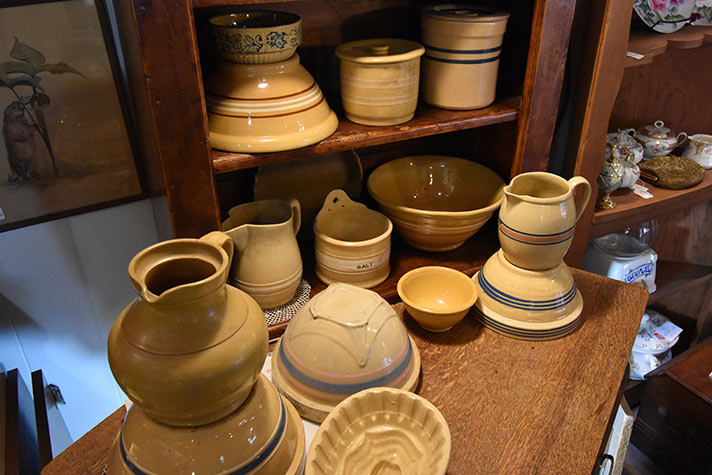Speaking of Antiquing – October 2019
Yellowware is one of those items that branches off from the original and creates other categories to collect.
Yellowware did not limit its purposes to the functioning of a kitchen with bowls, pitchers, cups and tankards, cannisters, saltshakers and salt boxes, storage jars, molds, teapots and coffee pots, tableware and bakeware. There were candlestick holders, match safes, whiskey jugs, piggy banks, in a wide variety of figures, flower vases, chamber pots, shaving mugs, bed warmers and even toys.
Scotland began importing yellowware pottery into the US in the late 1700’s. Great Britain also imported much fine china as well as stoneware. The Ohio soil proved best for import competition. The yellow earth clay of Ohio is famous and responsible for most of the pottery made in America.
Many companies partook in yellowware production including, Roseville, Brush-McCoy, Weller, Harker, Taylor & Co. The Brighton Pottery Co., and countless others whose stamps and marks are increasingly hard to read as time goes on.
Yellowware production in America spanned a good century between 1828 and 1930. Producers were also in Illinois, Pennsylvania, and New Jersey.
Canadian companies were also involved such as Brandtford Pottery, Cap Rouge Pottery, and Tara Pottery. The leader being Brandtford, had a distinctive purple-brown glaze developed in England called Rockingham. This created a sub-line called brown-glazed yellowware.
A bowl is a bowl, unless you are a yellowware bowl. The distinctive yellow color and thick rim band are your first clue. The vivid glaze and stripe detail are another. It’s interesting how many stripe and color arrangements bowls can have!
Examples abound. Sides slightly flared, a rolled rim, two thin chocolate brown stripes with a thicker brown stripe between, on the bowl’s upper section. Flared bowl, thick straight rim with two thin white stripes with a cobalt blue stripe between, placed on the rim and on the bowl’s upper section. Thick, unadorned slightly flared bowl with an almost 2” rim for ease of lifting is a heavy dough bowl.
Other bowls of similar shape with blue and pink stripes, white and pink, white and blue, some of the bottom sections scraped to create a beautiful design of swirls or striping in the clay. Mix up the colors, mix up the stripe size, mix up the rim bands or rolls, and you have many varieties of yellowware.
The Brandtford pottery in Canada used an interesting feature called seaweed mocha to decorate the rims and bands of bowls, creating a stunning moss-like design.
The thickness and sturdiness of the yellowware clay is indicative to its longstanding. You could have a bowl that is cracked or chipped, and it could still withstand daily use. Sometimes the chips and cracks add to its charm, so don’t pass up a bowl just for those “flaws.”
Choose your color scheme, your interesting item, find your pitcher or tankard, nappie or dough bowl, and let your yellowware collection begin or expand right here at Pickety Place in Jacksonville.

 Margaret Barns is co-owner of Pickety Place Antiques & Collectibles located at 130 N. 4th Street in Jacksonville. LIKE them on
Margaret Barns is co-owner of Pickety Place Antiques & Collectibles located at 130 N. 4th Street in Jacksonville. LIKE them on